
Учебное пособие 1862
.pdf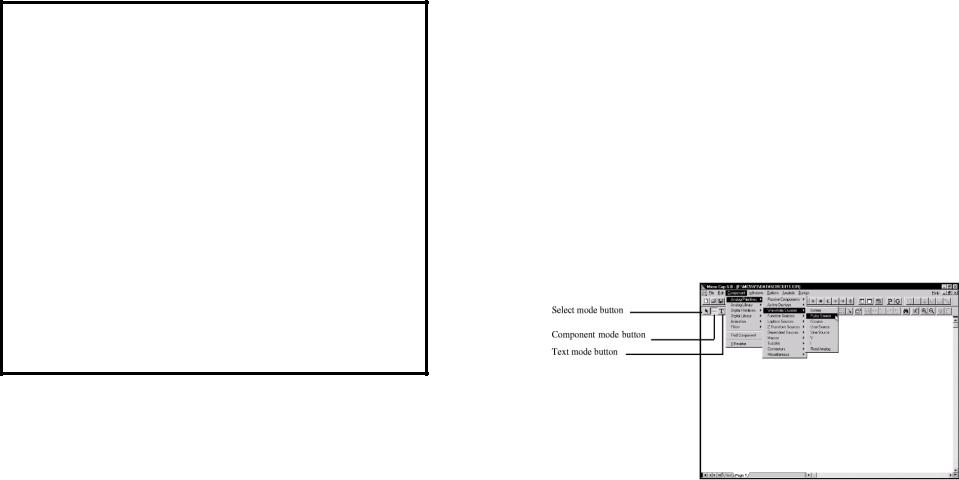
Chapter 3
Creating and Editing Simple Circuits
Ответьте на вопросы:
1.Как осуществляется идентификация узлов?
2.Скажите, в каком абзаце текста говорится о: а) буфере обмена б) копировании перетаскиванием
в) командах, осуществляющих удаление объектов
3.Скажите, что говорится в тексте о:
а) осуществлении редактирования параметров элементов схемы
б) осуществлении выбора элементов для редактирования
в) осуществлении редактирования параметров элементов текста
4.Что Вы узнали из текста о создании текстовых файлов
SPICE?
5.Расскажите, что Вы узнали из текста о приемах создания больших схем.
6.Какие наиболее важные идеи и методы были раскрыты в третьей главе?
What's in this chapter
This chapter shows you how to create and edit simple circuits. The goal of this chapter is to introduce the basic techniques and to refine them into working skills by practicing on sample circuits. The particular subjects covered are:
•Schematic creation
•Adding components
•Entering component parameters
79
•Connecting components with lines
•Using define and model statements
•Adding node names
•Schematic editing
•Text editing modes
•Editing component parameters and text
•Deleting objects
•The clipboard
•Selection
•Viewing large schematics
•Creating and editing SPICE text files
Creating a simple circuit
Begin by double-clicking the mouse on the MC6 icon. The program automatically opens a circuit window and names it CIRCUIT 1. Using the mouse, click the Component menu. Click the Analog Primitives item. Click the Waveform Sources item. Finally, click on the Pulse Source item.
Figure 3-1 Selecting from the Component menu
Selecting a part from the menu changes the mode to Component, anticipating the placement of the component in the schematic.
80

The cursor changes to a pulse source shape. Click the left mouse button and hold it down. Press the right mouse button and the shape rotates. Eight clicks of the right mouse button produce the eight possible orientations. While still holding the mouse button down, slide the source to a position halfway down the circuit window and near the left window edge. Rotate it until the plus symbol is on top and the minus symbol is on the bottom. Release the mouse button. This activates the Attribute dialog box as shown in Figure 3-2.
For a waveform source there are two important attributes, the part name and the model name. MC6 creates a suitable part name, in this case VI, which you can accept or edit. We'll accept the name VI. For parts from the Analog Primitives section of the library, we must specify a model name. Click on the MODEL attribute in the Attribute list box. This places the text cursor in the VALUE field of the MODEL attribute. You can type in a new model name or select a model from the Model list box. If you type in a name that is not in the Model library, MC6 places a default model statement in the text area. If you pick a part by selecting it from the Model list, MC6 copies its model parameters from the source library to the text area and stores them there in the form of a SPICE model statement
Figure 3-2 The Attribute dialog box
You can edit the parameters for the source by editing the model
statement in the text area, or you can edit the model parameters |
di- |
rectly by clicking on the Edit button. To illustrate, click on |
the |
81 |
|
SAWTOOTH source name in the Model list box. Click on the Edit button. The display should look like this:
Figure 3-3 Editing the model parameters
Clicking the Edit button produces a display of the model parameters. You can edit these as needed, and your changes will be saved in the text area model statement.
Suppose you wanted a sawtooth source with a VONE level of 10 volts instead of the 5 volts this one has. Click in the VONE field and change the value from 5 to 10, then click the OK button. This changes the VONE model parameter and saves it in the SAWTOOTH model statement in the text area. The text area is a part of each schematic used to store descriptive material such as model, define, macro, stimulus and other command statements. To view the text area, press CTRL + G, or click the Text area tab in the lower left scroll bar area. The text area should now look like Figure 3-4.
82

Figure 3-4 The text area of the schematic
Text area edits affect only the local circuit. To get back to the drawing area of the schematic, press CTRL+ G, or click the Page 1.
The Component menu hierarchical structure provides easy access to components, but it takes several steps to find the one you want. A fast way to select frequently used parts is the Component palette.
These user-selected parts palettes can be toggled on and off with a single key. You click on the part you want, then either leave the palette on the screen or make it disappear with the same key that invoked it. The palettes, numbered 1 to 9, are toggled on and off with CTRL + palette number.
For example, CTRL + 1 toggles palette 1 on and off. Membership in a Component palette is specified with the Component editor.
We'll use a palette to add a resistor. Press CTRL + 1 to invoke palette 1. The screen should look like this:
83
Figure 3-5 A user palette
Click on the Resistor name in the palette. Press CTRL + 1 to remove the palette. Drag the resistor to the source and rotate it until it is horizontal. When one of the resistor leads is just touching the top of the source, release the mouse button. If the Node Snap option is enabled, the resistor lead only needs to be near the source. The resistor lead will snap to the nearest node. Release the mouse button, and the Attribute dialog box will appear. MC6 suggests the name Rl which we'll accept. Click on the Value attribute, type "IK", and press ENTER.
Let's move the resistor part value text. To move anything we must be in Select mode. To activate Select mode, click on the Select
mode button  in the upper left portion of the Tool bar, or press CTRL + E. Drag the resistor part value, IK, until it is centered below the resistor body. Attribute text can be independently moved relative to the part by simply dragging it to the desired position. The initial position of attribute text relative to the part shape is specified in the Component editor. After the part is placed, its text attributes (e. g.
in the upper left portion of the Tool bar, or press CTRL + E. Drag the resistor part value, IK, until it is centered below the resistor body. Attribute text can be independently moved relative to the part by simply dragging it to the desired position. The initial position of attribute text relative to the part shape is specified in the Component editor. After the part is placed, its text attributes (e. g.
84
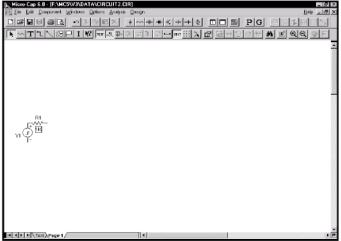
NAME and VALUE) can be moved as desired. Attribute visibility can also be toggled on and off from the Attribute dialog box.
Your schematic should now look like Figure 3-6.
Figure 3-6 The circuit after moving the value attribute
Select a new part from the Component menu or User palette only if the part is different from the last one chosen.
Now we'll add a part from the Analog Library. From the Component menu, select Analog Library / BJT / 2NOOOO- / 2N3725- / 2N4013. This selects the 2N4013, a pre-modeled bipolar NPN transistor. Drag the 2N4013 so that its emitter points down and its base touches the right resistor lead. The Attribute dialog box will not appear this time. That's because all of the components in the Analog Library and Digital Library sections of the Component library have their model names set equal to their component name. When you select the component name 2N4013, the model name is automatically known to be the same, and its model parameters are readily available in the model libraries. Since the part name and model name are already known, the Attribute dialog box isn't needed and doesn't appear. Less work is required to use a part from the Analog
85
Library and Digital Library sections of the Component menu than from the Analog Primitives and Digital Primitives sections. You simply pick a part from the library and drop it into the schematic. No modeling decisions are required. Components chosen from the Analog Primitives and Digital Primitives portion of the library, like the Pulse Source, require a specific model name, and eventually a specific model statement. The model statement itself may be selected from the libraries and edited or it may be typed in manually.
Invoke palette 1 again with CTRL + 1. Select Resistor from the palette, then click in the schematic and add a 10K resistor. Point it up from the collector lead. Select Battery from the palette, then click in the schematic to add a battery. Place it vertically so that its positive lead touches the top resistor lead. Set its value to 10. From the palette, select Ground. Place a ground vertically with its lead touching the negative battery lead. Add grounds to the NPN emitter and to the source minus lead. Toggle the palette off with CTRL +1. The circuit should now look like Figure 3-7.
Now we'll add an OP08_AD, a subcircuit model for the OP08 opamp supplied by Analog Devices. From the Component menu, select Analog Library / Vendor / Analog2 / OPO8_AD- / OPO8_AD. Place the opamp to the right of the NPN.
To illustrate a third way to select parts for placement, click on the
battery  button in the middle of the top row of the Tool bar. Click in the schematic and place a 4.0 volt battery vertically so that its positive lead touches the '99' or 'VCC lead of the OP08_AD.
button in the middle of the top row of the Tool bar. Click in the schematic and place a 4.0 volt battery vertically so that its positive lead touches the '99' or 'VCC lead of the OP08_AD.
Click on the ground  button in the Tool bar. Click in the schematic and place a ground at the negative lead of this battery and at the '50' or 'VEE' lead of the OP08_AD.
button in the Tool bar. Click in the schematic and place a ground at the negative lead of this battery and at the '50' or 'VEE' lead of the OP08_AD.
86

Figure 3-7 The circuit after adding the bipolar stage
Wire mode lets you connect components by dragging the mouse to create a wire.
For a wire to connect two leads together, the wire's endpoints must terminate on a lead or a wire connected to a component lead. To see
where the leads are, click on the Pin Connections  button. This draws a small dot at each component lead. You can also display pin names and connections individually for each component by enabling the Display Pin Names option from the Attribute dialog box.
button. This draws a small dot at each component lead. You can also display pin names and connections individually for each component by enabling the Display Pin Names option from the Attribute dialog box.
Click the Wire mode button  in the Tool bar (or press CTRL + W). This changes the mode so that dragging the mouse draws a wire to connect component leads. Place the mouse at the '3' or 'plus input' lead. Click the mouse button, and while holding it down, drag the mouse horizontally to the left until the wire touches the junction between the collector lead and the resistor lead. Release the mouse button. This connects the two leads together.
in the Tool bar (or press CTRL + W). This changes the mode so that dragging the mouse draws a wire to connect component leads. Place the mouse at the '3' or 'plus input' lead. Click the mouse button, and while holding it down, drag the mouse horizontally to the left until the wire touches the junction between the collector lead and the resistor lead. Release the mouse button. This connects the two leads together.
87
Figure 3-8 The circuit after wiring the OP08
Connect the '2' or 'minus input' lead to the '45' or 'output' lead by clicking near the output lead and dragging a wire straight down until it is below the opamp. While still holding the button down, drag the mouse to the left until it is just below the '2' lead. Release the mouse. This creates a right-angled wire extending from the output to an intermediate point below the input lead. Click again at this intermediate point to start a second wire. Drag it to the '2' lead, and release the mouse.
Text mode lets you place grid text anywhere in the schematic. Grid text is mainly used to name nodes. Text is not case sensitive, lu is the same as 1U.
From the Component menu / Digital Library / 74xxOO- / 04- /
7404, select the 7404 buffer. Place the buffer horizontally so that its input lead is to the right of the OP08. Draw a wire from the OP08 output lead to the 7404 input lead. Draw another wire from the 7404 output lead horizontally to the right. Finally, draw the final wire from the pulse source plus lead horizontally to the left.
88
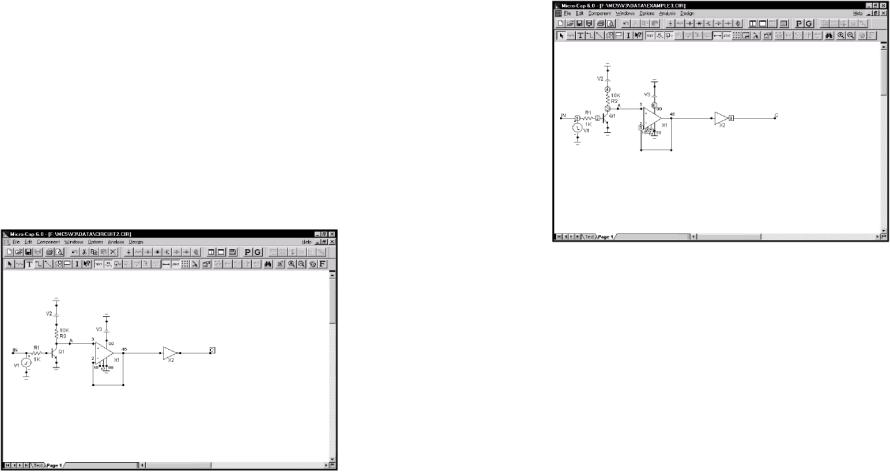
Click on the Text mode button  or press CTRL + Т to enter Text mode. In this mode you can add text to the schematic. Text placed directly on nodes gives the node a name which can be used to refer to it when plotting its node voltage or digital state. Click on the horizontal wire just added to the source. When the dialog box comes up, type "IN" and press the ENTER key. The lower edge of the selection box outlining the text "IN" should just touch the wire. If it doesn't touch, enable the Select mode and drag the text until it does touch. In a similar fashion, add the text "A" to the wire connecting the NPN collector to the OP08 plus input lead. Add the text "C" to the wire connected to the 7404 output.
or press CTRL + Т to enter Text mode. In this mode you can add text to the schematic. Text placed directly on nodes gives the node a name which can be used to refer to it when plotting its node voltage or digital state. Click on the horizontal wire just added to the source. When the dialog box comes up, type "IN" and press the ENTER key. The lower edge of the selection box outlining the text "IN" should just touch the wire. If it doesn't touch, enable the Select mode and drag the text until it does touch. In a similar fashion, add the text "A" to the wire connecting the NPN collector to the OP08 plus input lead. Add the text "C" to the wire connected to the 7404 output.
Figure 3-9 The completed circuit
Node names and numbers.
The circuit should now look like Figure 3-9. MC6 assigns node numbers to every analog and digital node to identify them. To see
the node numbers, click on the Node Numbers button  in the Tool bar. The circuit should look like this:
in the Tool bar. The circuit should look like this:
Figure 3-10 Node numbers
The program automatically assigns numbers to the circuit nodes when an analysis is requested or when the circuit is saved to disk. It displays them on the schematic only when the Node Numbers option is enabled. When you want to plot or print a node's voltage waveform you refer to the waveform as V(node name), where the node name may be either the node number assigned by the program or a text name assigned by you.
For the program to know about node names, they must be placed directly on the node. The lower left corner of the text outline box must be placed directly on the node. Node Snap, if enabled, makes this easier by moving the text to the nearest node within one grid. The Node Snap option is selected from Options menu / Preferences / Common Options / Circuit.
The system assigns and displays node numbers according to the following rules:
1.Ground is node number 0, but its node number is never displayed.
2.The other nodes are numbered from 1 to the highest node number.
90
89
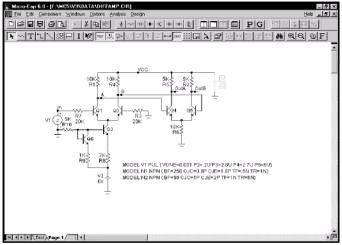
3.When an analog node and a digital node touch, or are connected by a wire, each node is assigned a unique number. The program automatically inserts an interface circuit between the two nodes. The interface circuit generates an interface node of the form <num>$ATOD or <num>$DTOA depending upon whether the digital node is an input or an output, respectively. If the interface node is accessible (can be referenced in a plot expression), it will be printed on the schematic. In general, interface nodes between analog parts and digital primitives are accessible unless they occur at a subcircuit interface. Since the interface node in this circuit occurs at a subcircuit interface it isn't accessible.
4.Analog node numbers are displayed in a box with rounded corners while digital node numbers are displayed in a box with square corners.
5.Nodes with the same text node name are connected together. This is done to provide a convenient way of connecting large numbers of common nodes.
Save this circuit using the Save As option from the File menu. Type "TUTOR" in the file name field. Remove the circuit by selecting Close from the File menu.
Editing component parameters and text
Schematics are composed of components, text, graphical objects, picture files, and wires. To edit any of these items, the item must be selected. To select an item, MC6 must be in the Select mode. To
enable the Select mode, press CTRL + E, click the Select  button in the Tool bar, or press SPACEBAR.
button in the Tool bar, or press SPACEBAR.
Once in the Select mode, objects or regions can be selected for editing, moving, or deleting. To illustrate, load the sample circuit DIFFAMP and click on the Select button in the Tool bar. Move the mouse to the 6V battery in the upper right part of the schematic. Click the mouse in the center of the battery. This selects the bat-
91
tery and redraws it using the Select color. The Select color, shown here as gray, can be changed through the Properties dialog box (F10).
Figure 3-11 Selecting the battery for editing
Double-clicking on a selected component activates the Attribute dialog box which lets you edit its attributes. Double click on the battery. MC6 presents the dialog box showing the highlighted value attribute 6V and awaits your edits. Type "6.5". Click OK. That's how you change the parameter of this simple part.
Editing model statements directly.
To change the forward beta of a transistor we must edit its BF model parameter. The model statement may be located in the drawing area or the text area of the schematic, or it may not even be in the schematic, but referenced indirectly via a .LIB statement. In this circuit, the model statements are in the drawing area of the schematic and are easily edited. To illustrate, click the N1 model statement text located near the bottom of the circuit. Click on it and the program redraws it in the select color to show its selected status.
92
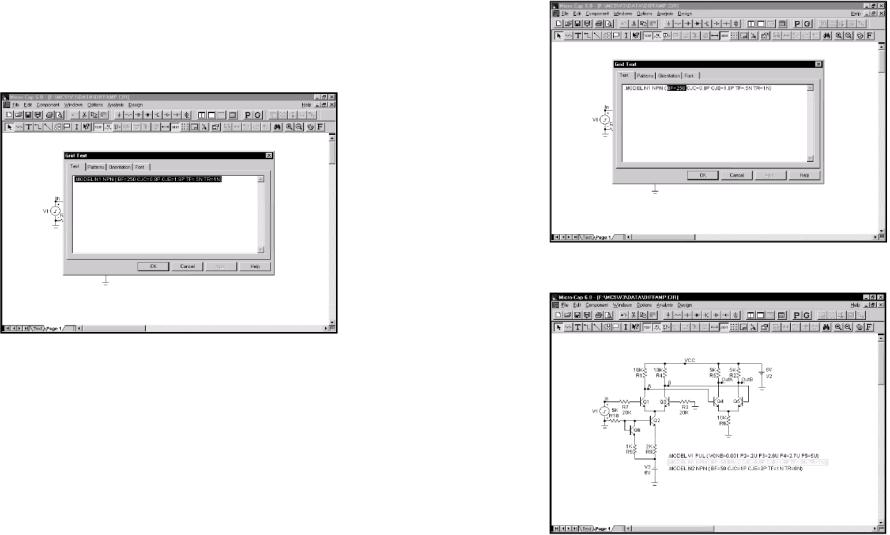
Double-click on it and the program presents a dialog box containing the text. The display now looks like Figure 3-12. The entire text of the model statement is highlighted or selected. If you type anything, the entire statement is replaced by what you type.
Figure 3-12 Selecting the N1 model statement for editing
We merely want to edit the beta value, so double-click the mouse on the 'BF' text. This deselects the entire text block and selects the text fragment 'BF=250 ' as shown in Figure 3-13.
Type "BF=50 ". This modifies the forward beta parameter. Suppose we also wanted to change the reverse beta value, BR. Since it is not yet in the model statement, we must add it. Click the mouse on any white space preceding a parameter name or following a parameter value and type "BR=2 ". All parameters are entered in the general form:
PARAMETER NAME=NUMERIC VALUE
Each entry must be preceded and followed by one or more spaces. Press ENTER or click the OK button and the screen should now look like this:
93
Figure 3-13 Selecting the 'BF=250 ' text for editing
Figure 3-14 Editing the model statement
The important things to remember about editing schematic text are: To edit a component's attributes, double-click on the component, then click on the attribute you want to edit, and start typing.
94
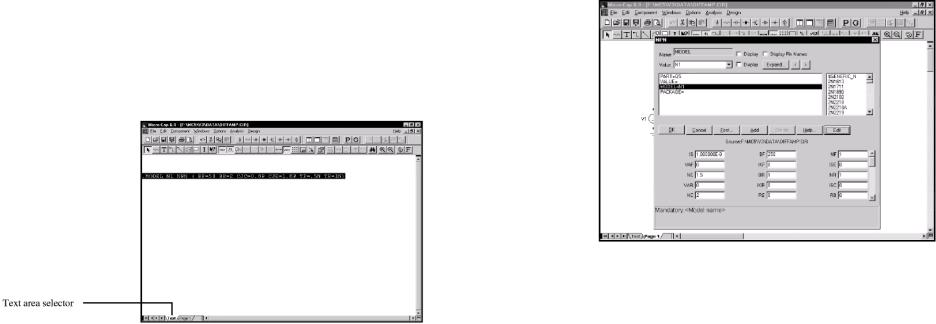
To edit a component's model statement or any other grid text, double-click on the text, then find the part you want to change, move the text cursor there with the mouse or the keyboard cursor keys and start typing.
Text may be moved from the drawing area of the schematic to the text area of the schematic or vice versa by selecting the text and pressing CTRL + B.
To switch the schematic display between the drawing and text areas click on the Text tab in the lower-left scroll bar area, or press CTRL + G.
Some users may prefer to have all of their text neatly tucked away in the text area where they can edit or review it. Others might prefer to keep the text visible in the schematic to remind them of important parameter values.
To illustrate, press CTRL + B. This moves any selected text to the text area. In this case, we have the N1 model statement selected. Click on the Text area selector or press CTRL + G to see the text area. The screen should look like this:
Figure 3-15 Moving schematic grid text to the text area
Remember, editing model statements is unnecessary for components selected from the Analog Library and Digital Library sections 95
of the Component library. Their model statements are accessed by MC6 directly from the disk-based Model library. You only need to edit a model statement when you want to define your own model or edit an existing model statement.
Click on the Revert  button to restore the DIFFAMP circuit. This discards any changes made and reloads the circuit file from disk.
button to restore the DIFFAMP circuit. This discards any changes made and reloads the circuit file from disk.
There is another way to edit model statements without bothering to locate the actual model statement text. To illustrate, double-click on the Q5 transistor. This invokes the Attribute dialog box. Click on the Edit button in the dialog box. The screen should look like this:
Figure 3-16 Using the Attribute dialog box to edit the model statement
MC6 searched for Q5's model statement, N1, and displayed it in the edit area of the dialog box. When searching for the model statement, MC6 first looks in the schematic and text area. If it doesn't find it there, it looks in libraries referenced by a .LIB statement, including the default master index, NOM.LIB. If it still doesn't find the model
96
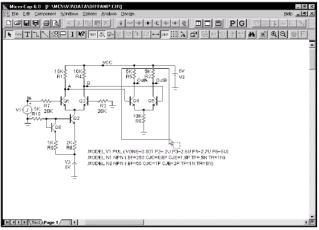
statement, it makes one up from default parameter values and copies it to the text area.
After locating the model statement (or creating a suitable default), MC6 displays the parameter values in the edit fields. You can scroll through the parameter values, editing them as you wish. When you click OK, MC6 updates your local copy of the model statement. The program never modifies any libraries as a result of these edits. It only modifies model statements local to the circuit.
You can click on any model name in the Model list box. Selecting one of these by clicking on it will change the part's model name attribute and will copy a new model statement to the text area when you exit the dialog box by selecting the OK button. The Cancel button cancels any changes made with the dialog box. Click the Cancel button.
Deleting objects
Clear saves clipboard contents. Cut replaces clipboard contents with deleted objects.
We can now edit text and component parameters. How about deleting objects? Like editing, deleting requires that the objects be selected. Once selected, they can be deleted with one of two commands; Cut and Clear. Clear, activated by the Del key, deletes without copying to the clipboard. Cut, activated by CTRL + X, deletes and copies to the clipboard. To illustrate, select the pulse source in the DIFFAMP circuit by clicking it. As usual the program colors it to show that it is selected. Press the Del key and the program removes the source.
Undoing operations
CTRL + Z will undo most operations.
MC6 provides an undo function to reverse the effects of all operations which change a schematic or a text field. To illustrate, press CTRL + Z to undo the deletion. The source, which we just deleted, reappears. Press CTRL + Z again and the source disappears again. All schematic and text editing functions are reversible to the prior
97
step. You cannot undo more than one step backwards.
The clipboard
MC6 maintains two clipboards for temporary storage. One is for schematics and the other is for text fields. There are two important clipboard operations.
To copy something to the clipboard, select it, then press CTRL + C. To paste the contents of the clipboard to a schematic, click the mouse on the schematic at the desired insertion point and press CTRL + V. The clipboard contents are then copied to the schematic and selected. They can be moved by dragging on any shaded object in the group. Clicking on any deselected object deselects all objects.
To illustrate, click on the Select button  in the Tool bar. Place the mouse at the upper left of the second differential stage of the DIFFAMP circuit. Drag the mouse to the lower right until the display looks like Figure 3-17. Upon release of the mouse button, objects originating inside the outline box are selected. Objects originating outside the box are not selected.
in the Tool bar. Place the mouse at the upper left of the second differential stage of the DIFFAMP circuit. Drag the mouse to the lower right until the display looks like Figure 3-17. Upon release of the mouse button, objects originating inside the outline box are selected. Objects originating outside the box are not selected.
Figure 3-17 Selecting a region for copying to the clipboard
Now press CTRL + С to copy the selected region to the clipboard. Move the mouse to the right of the battery and click the left button.
98
